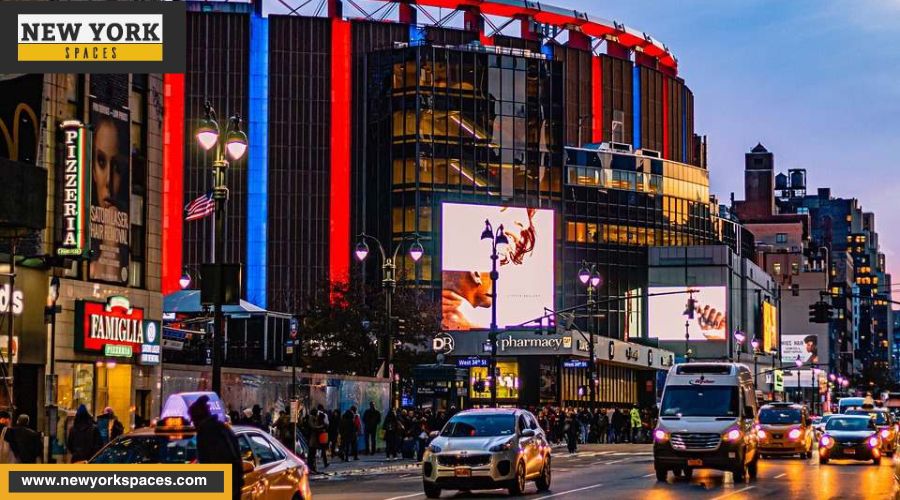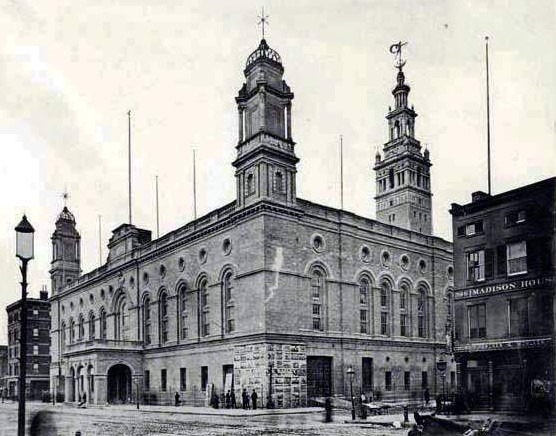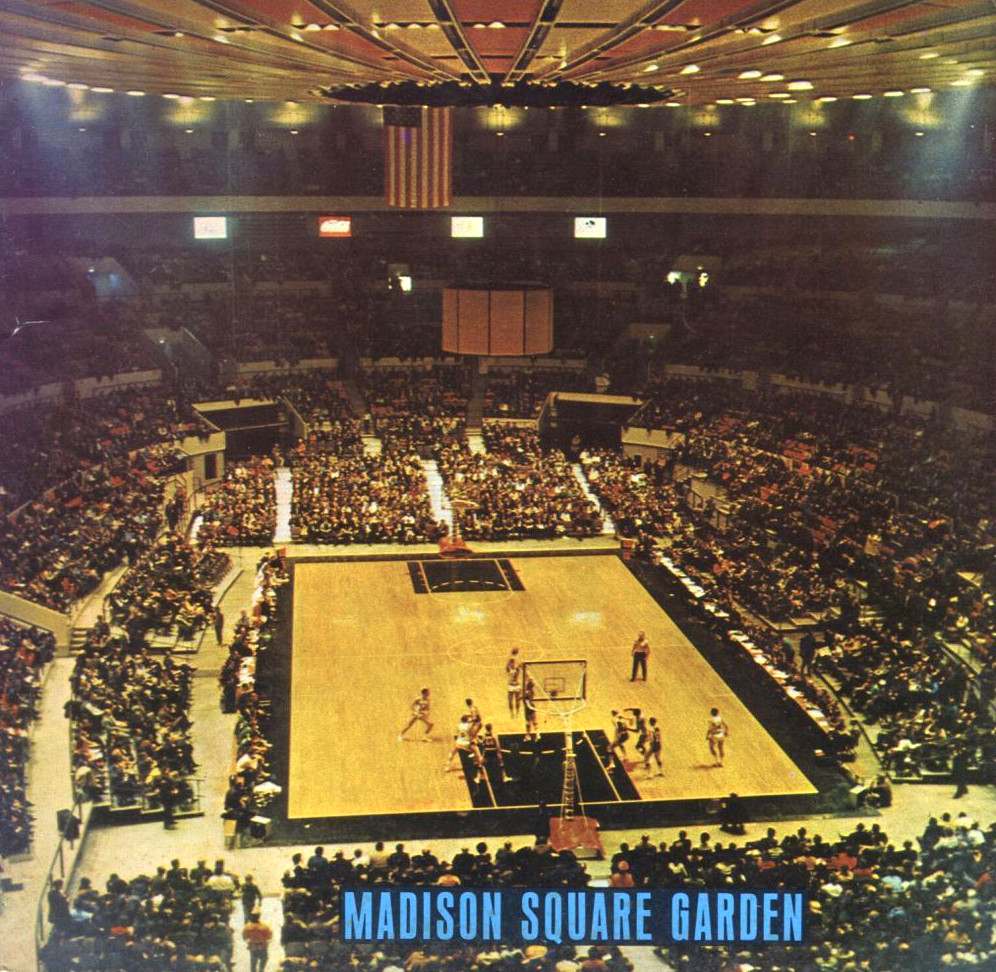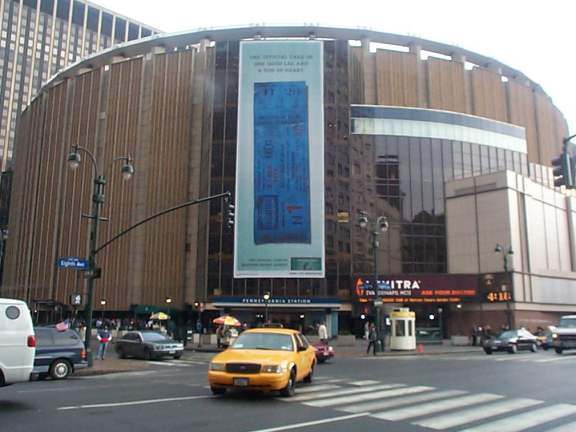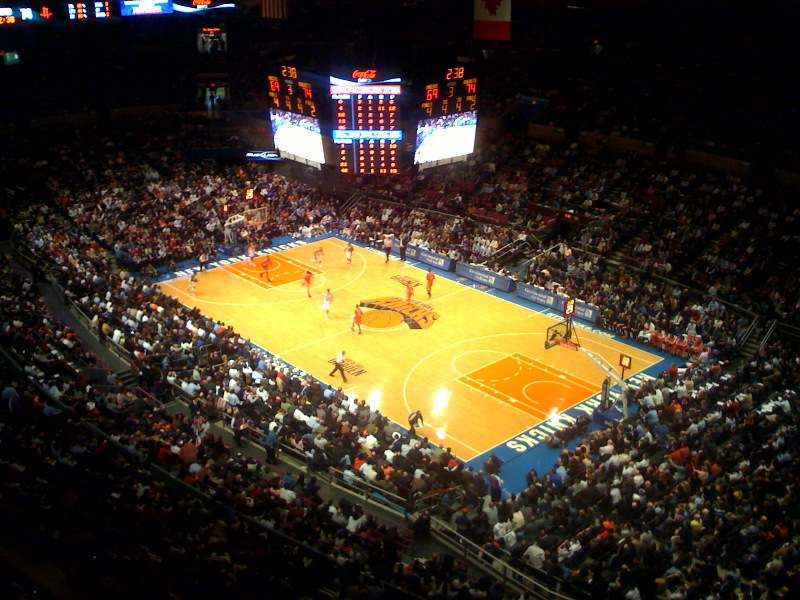Madison Square Garden is a name synonymous with the pulsating heart of New York City’s entertainment and sporting scene. Being located in Midtown Manhattan was one thing, but its entertainment prowess was another. It was named “Coolest Arena” by Rolling Stones and “Venue of the Decade” by Billboard in the United States. Filled with creation and destruction, the history of Madison Square Garden is alive even to this day and recalled by many. Why is Madison Square Garden famous?
There were three versions built in 1890, 1925, and the current version built in 1968. Let us talk more about how it came into existence and became one of the most iconic arenas of its time.
The First Madison Square Garden (1879-1890)
In 1879, the landscape of New York City was forever altered with the inauguration of the first Madison Square Garden. It was situated prominently at the northeast corner of Madison Avenue and 26th Street, near the verdant expanse of Madison Square Park.
Owned by William K. Vanderbilt, this venue mirrored the burgeoning cultural and social ambitions of the city. It quickly became a melting pot of diverse activities, hosting everything from dog shows and cattle displays to political conventions and operatic performances.
The Garden’s appeal was further enhanced by P.T. Barnum’s renowned circus, which became a yearly highlight, infusing vital financial stability into the venue.
However, despite its bustling atmosphere, it had a leaky roof and a dangerous balcony that had collapsed, leading to deaths. It was sold in 1887 and was eventually demolished in 1890.
The Second Madison Square Garden (1890-1925)
The second Madison Square Garden was erected in 1890 on the site of its predecessor. Constructed within a remarkably short timeframe of just one year, this iteration was driven by the need to ensure continuity in hosting events. The building project was a feat of determination and resourcefulness, with around-the-clock work by thousands of laborers.
Crafted under the architectural genius of Stanford White and backed by a powerful syndicate of investors, including the likes of W.W. Astor, P.T. Barnum, Andrew Carnegie, and J.P. Morgan, this structure was a spectacle of its time. Stanford White gave the building a Beaux-Arts structure with a Moorish vibe, a minaret-like tower modeled after Giralda, and a bell tower inspired by the Cathedral of Seville, soaring 32 stories. It became the city’s second-tallest building at the time of completion. It commanded views over Madison Square Park with its main hall, an enormous space measuring 200 by 485 feet.
This Garden was not just a structure but a crucible of innovation and sports. It offered permanent seating for 8,000 people and floor space for thousands more. It was here, in 1898, that Nikola Tesla astounded the world with the demonstration of the first radio-controlled robot. Moreover, it hosted the first American professional indoor football game, an ambitious venture by the World Series of Pro Football, though it didn’t quite capture the public’s imagination as its baseball counterpart did.
The Garden’s interior was a microcosm of New York’s bustling life, featuring ample seating in balconies and on the floor, a theater, a concert hall, the city’s most sizable restaurant, and a roof garden cabaret.
During its tenure, the second Madison Square Garden prioritized events like the Ringling Bros. and Barnum & Bailey Circus, which, since its debut in 1919, drew massive crowds. This focus on the circus was so pronounced that it even impacted major sporting events, as seen in 1928 during the Stanley Cup final when the New York Rangers had to play all their games on the road due to scheduling conflicts with the circus. Nonetheless, the Rangers triumphed, clinching the cup in this unique scenario.
Despite these impressive features, the venue struggled to draw enough crowds to be deemed a financial success. This led the property’s owners, the New York Life Insurance Company, to decide in favor of constructing their new headquarters, resulting in the Garden’s replacement by the Cass Gilbert-designed New York Life Building in 1925.
The second Madison Square Garden has also witnessed a terrible tragedy as its architect was murdered in the same place he helped build. Stanford White was a friendly man, but he was a seducer of young women. Model and chorus girl Elizabeth Nesbit was one of the girls who unsurprisingly became affectionate towards Mr. White while he was 42 and she was 16. As the relationship moved on its course, Nesbit was assaulted while unconscious in Mr. White’s 24th Street apartment.
Nesbit would go on to marry Harry Kendall Thaw, heir to a coal fortune but a mentally unstable one. Upon learning about Nesbit’s past, Harry becomes jealous, pushing him to the point of no return. Harry encountered Stanford White in 1906, on the evening of June 25, in Madison Square Garden, and repeatedly shot White in the chest and face as the show came to a close. While White died on the spot, Harry would face murder charges and undergo the “Trial of the Century.”
The Third Madison Square Garden (1925-1968)
In 1925, the saga of Madison Square Garden unfolded anew as it relocated uptown to the junction of Eighth Avenue and 50th Street. Designed by theater architect Thomas W. Lamb and financed by boxing promoter Tex Rickard, this third incarnation of the Garden came to life at the cost of nearly five million dollars. Constructed in a swift 249 days, it was aptly nicknamed “The House That Tex Built.” Designed with a grand vision, this Garden could seat 18,496 spectators, primed especially for boxing matches.
This era of Madison Square Garden also signaled the entry of the National Hockey League’s New York Rangers. Interestingly, they weren’t the inaugural New York team to play there – that honor went to the New York Americans in 1925. Their first game, although a loss to the Montreal Canadiens, drew an impressive crowd of 17,000. Inspired by the Americans’ initial success, Rickard formed his own NHL team, the New York Rangers, which debuted in the Garden in 1926.
The Rangers’ journey was marked by triumphs, including three Stanley Cups between 1928 and 1940. However, post-World War II, the New York Americans ceased to play, leaving the Rangers without their former arena companions. This departure led to the infamous “Curse of 1940,” a superstition linked to the Rangers’ long wait for another Stanley Cup win, which wouldn’t come until 1994. Hockey lore even suggests that in celebration of their 1940 victory, the Rangers’ manager burned the Garden’s mortgage papers in the Stanley Cup, a gesture some believed contributed to the “curse.”
This Madison Square Garden wasn’t just a haven for hockey; it hosted notable boxing and wrestling events, the annual Westminster Dog Show, and was a favored venue for the circus. The Ringling Bros.’ frequent bookings often meant the Rangers had to vacate their home turf. This pattern continued until the Rangers played their final game there in 1968, moving to a new and more accommodating Madison Square Garden.
In addition to sports, the Garden became a stage for political rallies during WWII, and in the 1950s, it featured the biggest stars of the entertainment world. One memorable event in 1957 included appearances by Elizabeth Taylor and Marilyn Monroe for a Mike Todd production. Monroe’s iconic 1962 performance of “Happy Birthday Mr. President” for John F. Kennedy also graced this Garden’s stage.
As plans for demolishing Rickard’s Madison Square Garden were set in motion, its doors remained open until the latest iteration was ready. In 1968, after its demolition, the site temporarily served as a parking lot before transforming into Worldwide Plaza in 1989.
The Fourth Madison Square Garden (1968-Present)
In 1959, the landscape of New York City’s entertainment domain was set for a significant transformation when Graham-Paige, a former automobile manufacturer, invested four million dollars for a 40% stake in Madison Square Garden. Quickly escalating their influence, they gained control of the venue.
The next year, the company’s president, Irving Mitchell Felt, purchased construction rights at Pennsylvania Station from the Pennsylvania Railroad. This action involved demolishing the ground-level sections of the original station, a move that sparked public outrage due to the loss of its celebrated Beaux-Arts architecture. Although the new Pennsylvania Station was a marvel in itself, it faced criticism from architectural historians, and this controversy eventually led to the establishment of the New York City Landmarks Preservation Commission.
The fourth iteration of the Garden was opened on February 11, 1968. At that time, it was originally named Madison Square Garden Center. Coinciding with this was the emotional farewell game of the New York Rangers against the Detroit Red Wings at the third Madison Square Garden. After this, the final event at the third Garden was the Westminster Dog Show, concluding its chapter in New York’s history.
The next day, February 12, 1968, ushered in a new era for the Garden, now home to the NHL’s New York Rangers and the NBA’s New York Knicks. This transition was met with a mix of excitement and nostalgia as the city embraced its new sports and entertainment landmark.
However, the journey was not without its controversies. In 1972, Irving Mitchell Felt’s proposal to move the Knicks and Rangers to New Jersey’s Meadowlands Sports Complex met with considerable resistance. The saga intensified in 1977 when Gulf and Western Industries purchased Madison Square Garden. The ensuing dispute over real estate taxes between the arena and New York City, spurred by Felt’s initiatives, reached a climax in 1980 when the Garden contested its tax bill. The resolution that followed established Madison Square Garden as a tax-exempt entity under the condition that it remains the home for the Knicks and Rangers games.
Architectural Evolution of the Madison Square Garden
Madison Square Garden has undergone a remarkable architectural metamorphosis throughout its existence, evolving from a classic design to a contemporary icon.
First Madison Square Gardens
The first two iterations of Madison Square Garden, located near Madison Square Park, reflected the architectural styles and urban planning of their respective times. The original Garden, built in 1879, was primarily a functional structure without significant architectural embellishments, focusing on versatility for various events.
Second Madison Square Gardens
The architectural grandeur of the second Madison Square Garden, constructed in 1890, was a landmark moment in the architectural narrative of New York City. Overseen by Stanford White, one of the era’s most distinguished architects, the design was a product of visionary minds, including a group of influential investors such as W.W. Astor, P.T. Barnum, and J.P. Morgan.
Dominating the skyline, this 32-story structure stood as New York City’s second tallest building at the time, symbolizing the city’s ambitious architectural ascent. Overlooking Madison Square Park, its towering presence was accentuated by a main hall, an expansive 200 by 485-foot space that was the world’s largest upon its completion.
This architectural masterpiece was not just a venue; it was a beacon of innovation. Stanford White’s design blended grandeur with functionality, creating a space that could host a myriad of events, from sporting activities to grand social gatherings. Its interior was a testament to architectural finesse, featuring opulent seating arrangements, a theater, a concert hall, a large restaurant, and a roof garden cabaret, all embodying the lavish lifestyle of the era.
Despite its architectural magnificence, the Garden faced challenges in attracting sufficient crowds to sustain its operations, leading to its eventual demolition in 1925 to make way for the New York Life Insurance Company’s headquarters. Yet, the legacy of its architectural style remained, marking a significant chapter in the history of Madison Square Garden and New York City’s architectural evolution.
Third Madison Square Gardens
In 1925, as New York City continued to redefine its skyline, the third Madison Square Garden emerged at the corner of Eighth Avenue and 50th Street. This iteration, steeped in the architectural ingenuity of Thomas W. Lamb, was a distinct departure from its predecessors, reflecting the changing ethos of the time.
Costing nearly five million dollars and constructed in a mere 249 days, the third Garden was the brainchild of boxing promoter Tex Rickard, earning the nickname “The House That Tex Built.” With its maximum capacity of 18,496, the arena was specifically designed with boxing matches in mind, showcasing Lamb’s ability to fuse practicality with architectural aesthetics.
The design of this Garden, while modern for its time, still carried echoes of classical styles, reflecting Lamb’s expertise in creating spaces that were both grand and functional. The interior design was accommodating for not just boxing but also for other sports, notably becoming the new home for the National Hockey League’s New York Rangers. This was a venue that saw the first steps of the Rangers, a team that would go on to become synonymous with New York City’s sporting culture.
Additionally, the third Garden was a venue that adapted to a variety of events, from iconic sports matchups to large-scale political rallies and star-studded entertainment events. Its architectural versatility allowed it to cater to diverse crowds, from passionate sports fans to the elite of the entertainment world.
However, despite its architectural and cultural significance, the third Madison Square Garden eventually made way for the new, making room for further urban development. Its demolition in 1968 paved the way for the fourth and current Madison Square Garden, a venue that would continue to write history in the heart of New York City.
The Fourth and Current Garden
The current Madison Square Garden, opened in 1968, represents modern architectural principles. Designed by Charles Luckman Associates and Brisbin Brook Beynon Architects, it stands as a multi-purpose indoor arena, integrating elements of contemporary design and state-of-the-art facilities. The structure, located between Seventh and Eighth Avenues from 31st to 33rd Street above Pennsylvania Station, is part of the Pennsylvania Plaza office and retail complex.
Over the years, Madison Square Garden has seen significant renovations to maintain its status as a premier venue. The renovations in 1989-1991 and more extensively in 2011-2013, designed by Brisbin Brook Beynon Architects, modernized the arena while retaining its iconic status. These updates included technological enhancements and aesthetic improvements, ensuring that the Garden remained a top-tier venue for sports and entertainment. As a result, Madison Square Garden has become one of the most expensive stadium venues ever built.
Significant Events and Performances at Madison Square Garden
Madison Square Garden has been the setting for an array of historic events and performances, each contributing to its legacy as one of the world’s most renowned venues.
Sports
- Boxing Glory: Madison Square Garden earned its reputation as the “Mecca of Boxing,” hosting some of the most iconic bouts in the sport’s history. The Garden was the chosen venue for legendary fights, including the first Joe Frazier vs. Muhammad Ali bout in 1971, known as the “Fight of the Century.”
- Basketball and Hockey: Since 1968, the Garden has been home to the New York Knicks (NBA) and the New York Rangers (NHL), hosting countless memorable games. It’s the oldest arena in the NBA and the second oldest in the NHL, a testament to its enduring appeal.
Music and Entertainment
- Concerts: The Garden has been a premier destination for major music concerts. It has hosted a plethora of iconic artists and bands across various genres. Artists like Billy Joel, Elton John, Eric Clapton, Bob Dylan, and Neil Diamond have held numerous concerts in this venue.
- Professional Wrestling: Madison Square Garden has a deep connection with professional wrestling, especially with WWE. It has hosted several WrestleMania events, the first being in 1985, and continued to be a favored venue for major wrestling events.
Other Cultural Events
- Political and Social Gatherings: Throughout its history, the Garden has been a focal point for significant political and social events, including presidential rallies and cultural gatherings.
Conclusion
Madison Square Garden, through its various incarnations, has become an irreplaceable part of New York City’s cultural and architectural landscape. Its evolution from a humble showground to a modern-day icon mirrors the growth and transformation of the city itself. Each version of the Garden has served as a beacon of the city’s changing tastes, trends, and social currents.
As we look back on the storied history of Madison Square Garden, it’s clear that it’s not just any other venue – it’s a landmark that represents the spirit and resilience of New York City. The Garden stands as a testament to the city’s ability to reinvent itself, maintaining its relevance and appeal through the ages. As it continues to host events and welcome visitors from around the world, Madison Square Garden remains a symbol of the enduring vibrancy and dynamism of New York City.

